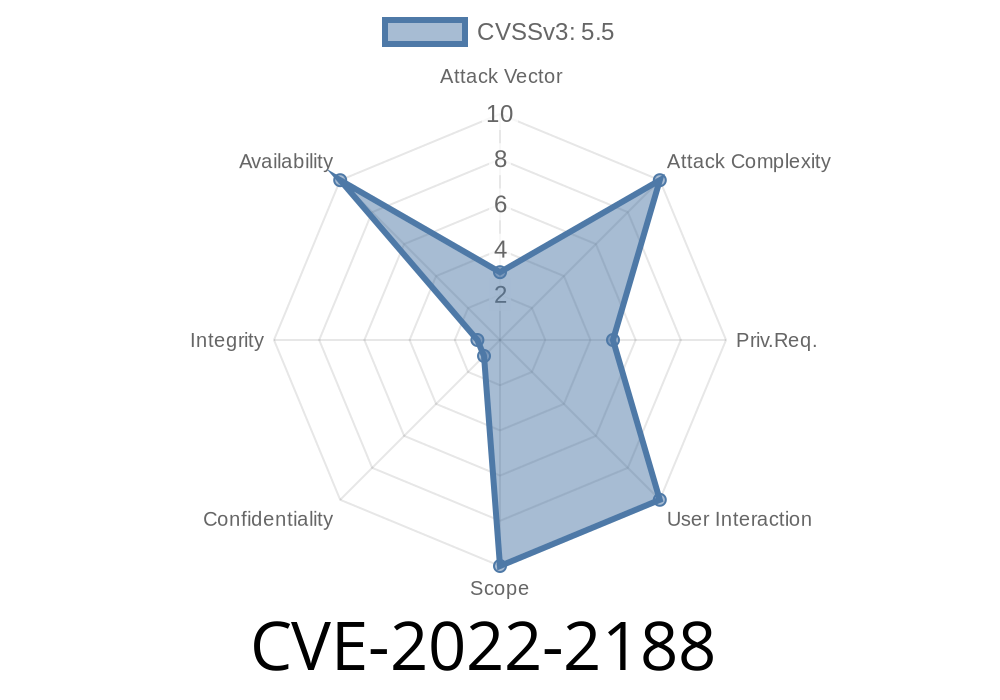In early 2022, researchers discovered a privilege escalation vulnerability—CVE-2022-2188—in the DXL Broker for Windows. This flaw allows local users to gain elevated privileges by exploiting insecure permissions in the log files directory. If left unpatched, attackers can even cause denial-of-service (DoS) to the DXL Broker service. Here’s a detailed, clear breakdown of how this vulnerability works and how to fix it.
2. What is DXL Broker?
DXL Broker is part of the McAfee Data Exchange Layer (DXL), a messaging service used to share threat intelligence and facilitate integration between McAfee products and third-party security tools. It’s often deployed in enterprise settings on Windows servers.
3. Understanding CVE-2022-2188
CVE ID: CVE-2022-2188
Products Affected: DXL Broker for Windows before version 6...280
Attack Vector: Local
Attack Complexity: Low
Privileges Required: Low
What's the vulnerability?
The vulnerability is caused by improper access control on the log directory, usually located at something like C:\Program Files\McAfee\DXLBroker\logs. By default, this directory might allow any local user write or even full control permissions. This means a regular user can plant malicious files or replace log files with symlinks.
4. Technical Breakdown
When the DXL Broker runs, it assumes the logs directory is secure. However, improper permissions mean an attacker can:
- Replace a log file with a symbolic link pointing to a sensitive system location (like C:\Windows\System32\drivers\etc\hosts).
- The DXL Broker, running as SYSTEM or another privileged account, writes to the symlink, unintentionally overwriting protected files.
- This can result in privilege escalation or even stop the DXL Broker from starting—causing denial of service.
File Permissions Example (Insecure)
# Command prompt: Check current log dir permissions
icacls "C:\Program Files\McAfee\DXLBroker\logs"
Output
C:\Program Files\McAfee\DXLBroker\logs Everyone:(OI)(CI)(F)
Here, Everyone has Full Control. This is the root of the problem.
5. Exploit Code Example
Let’s look at a simplified proof-of-concept (PoC) for Windows. This code simulates how a local attacker might exploit the bug.
Step 1: Remove the Legitimate Log File
del "C:\Program Files\McAfee\DXLBroker\logs\broker.log"
Step 2: Create a Malicious Symlink (Using mklink)
:: This requires admin, but you could also use NTFS hardlinks for some privileged writes
mklink "C:\Program Files\McAfee\DXLBroker\logs\broker.log" "C:\Windows\System32\drivers\etc\hosts"
Step 3: Wait for DXL Broker to Write Logs
When the DXL Broker restarts or writes the next log entry, it writes to the malicious link, overwriting the system file.
> Tip: Attackers may use advanced techniques to avoid admin by targeting files that regular users can symlink to. The core issue is the weak folder permissions.
6. Impact and Risks
- Privilege Escalation: An attacker running code as a regular user could overwrite system files, potentially running arbitrary code with SYSTEM rights.
- Denial-of-Service: Overwriting required files or locking them causes the DXL Broker to crash or refuse to start.
7. Mitigation Steps
DXL Broker for Windows 6...280 and later fix this by setting log directory permissions only to the DXL service account.
How to Fix
1. Upgrade: Install DXL Broker 6...280 or later.
`shell
icacls "C:\Program Files\McAfee\DXLBroker\logs" /inheritance:r
icacls "C:\Program Files\McAfee\DXLBroker\logs" /grant "NT SERVICE\DXLBroker:(OI)(CI)F"
Replace DXLBroker with the actual service account if different.
3. Monitor logs: Regularly review file and folder permissions, at least for any process running as SYSTEM.
8. Conclusion
CVE-2022-2188 may look simple, but its impact is severe in any environment using DXL Broker on Windows. Weak log directory permissions let attackers gain more power or take down a core security service. Always update to the latest version and review your security posture frequently.
9. References
- NVD CVE-2022-2188
- Trellix Security Advisory
- Microsoft - Understanding and Managing File and Folder Permissions
- Exploit-DB: Windows Privilege Escalation via Insecure Directory Permissions
Stay safe, and always keep your software—and its folder permissions—up to date!
Timeline
Published on: 11/07/2022 12:15:00 UTC
Last modified on: 11/08/2022 04:24:00 UTC
